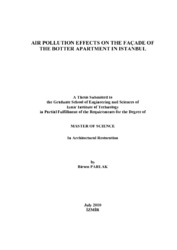Please use this identifier to cite or link to this item:
https://hdl.handle.net/11147/4032| Title: | Air pollution effects on the façade of the botter apartment in İstanbul | Authors: | Parlak, Birsen | Advisors: | Böke, Hasan | Publisher: | Izmir Institute of Technology | Abstract: | Air pollution showed a large increase with the rapid development of industry in the middle of the 18th century. Air pollution has been affecting cultural heritage along with human health. Limestone is one of the most affected building materials from the air pollution. Carbon, sulphure and nitrogen gases are the main components which are affective in the deterioration of limestone and their rate increased with air pollution. Sulphure dioxide (SO2) reacts with the calcite crystals (CaCO3) that are the main structure of limestone and leads to the formation of gypsum (CaSO4.2H2O). In this study, the formation of gypsum on limestone was investigated on the façade of the Botter Apartment within the restoration and conservation studies. For this purpose physical, mineralogical and chemical compositions of weathered limestone were determined by XRD, SEM-EDS, FT-IR and TGA analyses. The weathering forms caused by air pollution were documented with drawing (mapping) and photographs of front façade of Botter Apartment.The results of the study indicated that gypsum formation on limestone surfaces is mainly originated from wet and dry deposition process of sulphur dioxide. Condensation may also play an important role in gypsum formation on such sheltered surfaces in addition to dry deposition. On sheltered surfaces of limestone, due to the dry deposition of gypsum formation proceeds as black crust formation. The gypsum formation has not restricted on the surface of limestone. Deeper penetration and absorption of sulphure dioxide are observed in limestone because of their more porous structure. In Istanbul average daily temperature is low and average relative humidity and sulphure dioxide concentrations are high in winter time. The results of this study indicated that İstanbul atmosphere, with its coinciding high relative humidity and high sulphure dioxide concentrations in winter have led to gypsum formation on limestone. This situation has been encountered in all calcareous stones used in the construction of the buildings. | Description: | Thesis (Master)--Izmir Institute Of Technology, Architectural Restoration, Izmir, 2010 Includes bibliographical references (leaves: 68-72) Text in English; Abstract: Turkish and English xi, 72 leaves |
URI: | http://hdl.handle.net/11147/4032 |
| Appears in Collections: | Master Degree / Yüksek Lisans Tezleri |
Files in This Item:
| File | Description | Size | Format | |
|---|---|---|---|---|
| T000117.pdf | MasterThesis | 21.57 MB | Adobe PDF |  View/Open |
CORE Recommender
Page view(s)
208
checked on Apr 15, 2024
Download(s)
278
checked on Apr 15, 2024
Google ScholarTM
Check
Items in GCRIS Repository are protected by copyright, with all rights reserved, unless otherwise indicated.